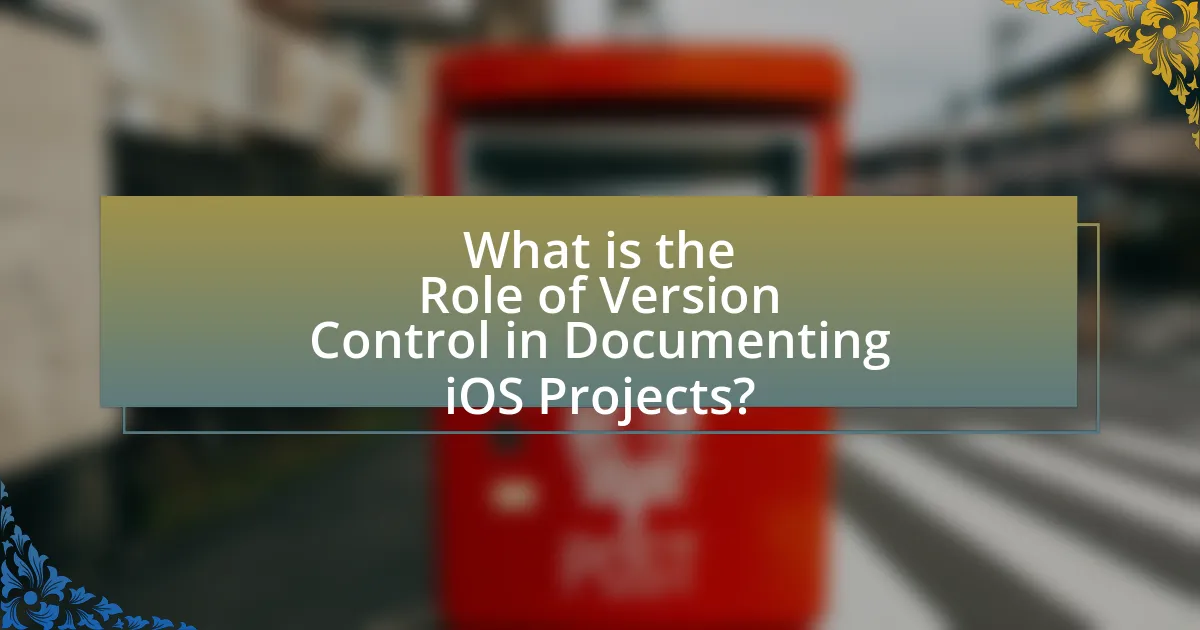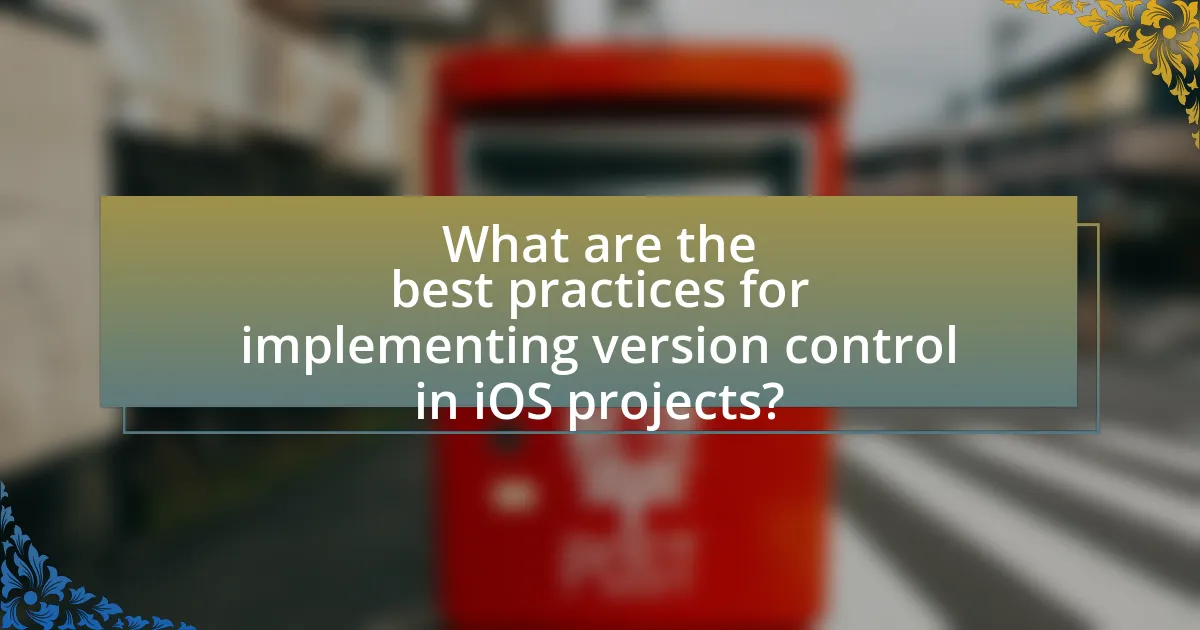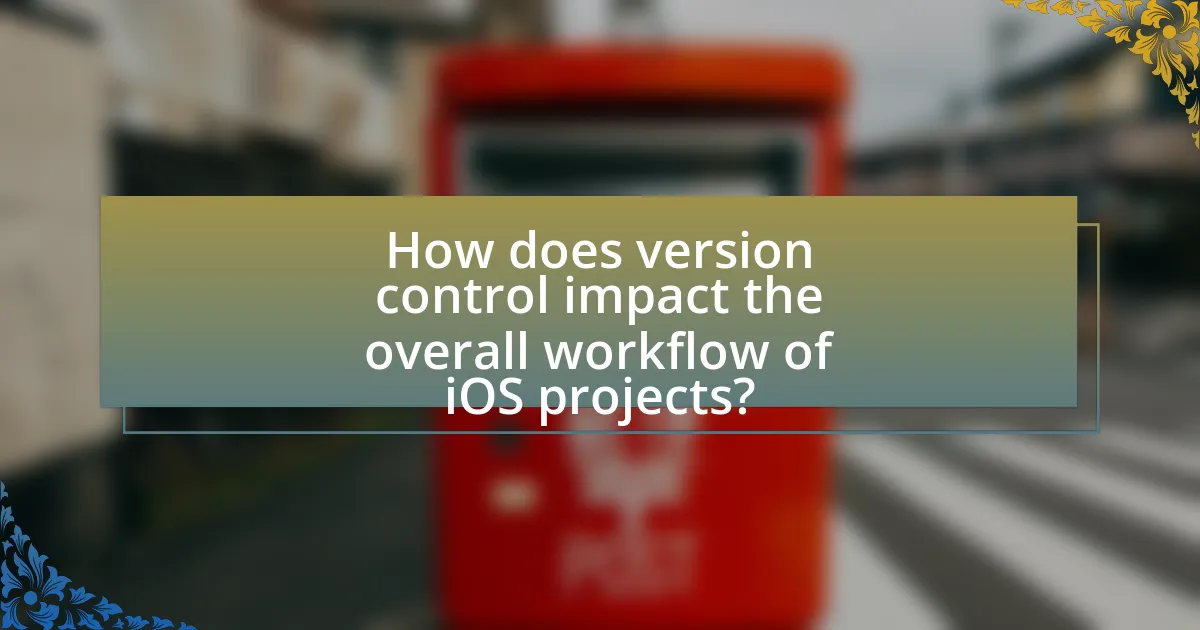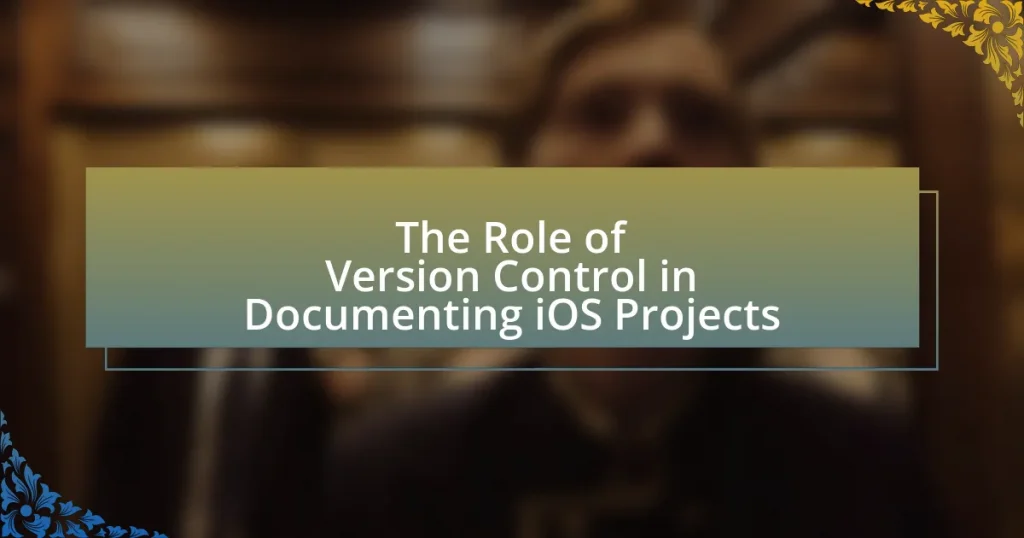Version control is a critical component in documenting iOS projects, enabling systematic tracking of changes to code and project files. It facilitates collaboration among developers by maintaining a clear history of modifications, allowing for easy access to previous versions and enhancing project organization. Key components of version control systems, such as repositories, branches, commits, and merge requests, interact to improve documentation accuracy and clarity. Best practices for implementing version control include using a distributed system like Git, maintaining a clear branching strategy, and committing frequently with meaningful messages, all of which contribute to streamlined workflows and effective project management.

What is the Role of Version Control in Documenting iOS Projects?
Version control plays a crucial role in documenting iOS projects by enabling systematic tracking of changes made to the codebase and project files. This allows developers to maintain a clear history of modifications, facilitating collaboration among team members and ensuring that previous versions can be easily accessed or restored if necessary. For instance, tools like Git provide features such as branching and merging, which help manage different development paths and integrate contributions from multiple developers seamlessly. Additionally, version control systems often include commit messages that serve as documentation for the rationale behind changes, enhancing the understanding of project evolution over time. This structured approach not only improves project organization but also aids in debugging and maintaining code quality, as developers can pinpoint when and why specific changes were made.
How does version control function within iOS project documentation?
Version control functions within iOS project documentation by systematically tracking changes to code and documentation, enabling developers to manage revisions effectively. This process allows teams to collaborate seamlessly, as version control systems like Git maintain a history of modifications, making it easy to revert to previous versions if necessary. Additionally, version control facilitates branching, allowing developers to work on features or fixes independently without disrupting the main codebase. This structured approach not only enhances collaboration but also ensures that documentation remains up-to-date and accurately reflects the current state of the project, thereby improving overall project management and reducing the risk of errors.
What are the key components of version control systems used in iOS projects?
The key components of version control systems used in iOS projects include repositories, branches, commits, and merge requests. Repositories serve as the central storage for project files and their history, allowing developers to track changes over time. Branches enable parallel development by allowing multiple versions of the code to exist simultaneously, facilitating features or bug fixes without affecting the main codebase. Commits represent individual changes made to the code, capturing the state of the project at specific points, while merge requests are used to integrate changes from different branches, ensuring that code is reviewed and tested before being merged into the main branch. These components collectively enhance collaboration, maintain project history, and streamline the development process in iOS projects.
How do these components interact to facilitate documentation?
Version control systems, documentation tools, and collaborative platforms interact to facilitate documentation by ensuring that changes are tracked, easily accessible, and collaboratively managed. Version control systems like Git maintain a history of document revisions, allowing users to revert to previous versions and understand the evolution of the documentation. Documentation tools, such as Markdown editors, enable structured content creation, while collaborative platforms like GitHub or Bitbucket provide a space for team members to contribute, review, and comment on documentation. This interaction enhances clarity, consistency, and accuracy in documentation, as evidenced by studies showing that teams using version control report a 30% increase in documentation quality and efficiency.
Why is version control essential for iOS project documentation?
Version control is essential for iOS project documentation because it enables systematic tracking of changes, ensuring that all modifications are recorded and can be reverted if necessary. This capability is crucial in collaborative environments where multiple developers contribute to the same codebase, as it prevents conflicts and loss of information. Furthermore, version control systems like Git provide a historical record of project evolution, allowing teams to understand the rationale behind changes and maintain a clear audit trail. This structured approach enhances project management and facilitates better communication among team members, ultimately leading to more efficient development processes.
What advantages does version control provide in tracking changes?
Version control provides significant advantages in tracking changes by enabling precise documentation of modifications made to code or documents over time. This system allows developers to view the history of changes, facilitating easy identification of when specific alterations were made and by whom. For instance, Git, a widely used version control system, maintains a detailed log of commits, which includes timestamps and author information, ensuring accountability and traceability. Additionally, version control systems support branching and merging, allowing multiple developers to work on different features simultaneously without conflicts, thus enhancing collaboration and efficiency in iOS project development.
How does version control enhance collaboration among iOS developers?
Version control enhances collaboration among iOS developers by enabling multiple team members to work on the same codebase simultaneously without conflicts. This system allows developers to track changes, revert to previous versions, and manage contributions from different team members effectively. For instance, tools like Git facilitate branching, where developers can create separate lines of development, test new features, and merge changes back into the main project seamlessly. This process minimizes the risk of overwriting each other’s work and ensures that all contributions are documented and traceable, which is crucial for maintaining code quality and project integrity.

What are the best practices for implementing version control in iOS projects?
The best practices for implementing version control in iOS projects include using a distributed version control system like Git, maintaining a clear branching strategy, committing frequently with meaningful messages, and regularly merging changes to avoid conflicts. Git is widely adopted in the software development community, providing robust features for tracking changes and collaboration. A clear branching strategy, such as Git Flow, helps manage features, releases, and hotfixes systematically. Frequent commits with descriptive messages enhance project documentation and facilitate easier code reviews. Regular merging of branches minimizes integration issues, ensuring that the main branch remains stable and up-to-date. These practices collectively enhance collaboration, maintain project integrity, and streamline the development process in iOS projects.
How can developers effectively manage version control systems?
Developers can effectively manage version control systems by implementing consistent branching strategies, utilizing commit messages that clearly describe changes, and regularly merging code to avoid conflicts. Consistent branching strategies, such as Git Flow, help organize development efforts and facilitate collaboration among team members. Clear commit messages enhance the understanding of project history, making it easier to track changes and identify issues. Regularly merging code reduces the likelihood of conflicts and ensures that all team members are working with the most up-to-date version of the project. According to a study by GitHub, teams that adopt structured workflows and maintain clear documentation experience a 30% increase in productivity and a significant reduction in merge conflicts.
What strategies can be employed to maintain clear commit messages?
To maintain clear commit messages, developers should adopt a structured format that includes a concise summary of changes, the rationale behind those changes, and any relevant issue tracking references. This strategy ensures that each commit message is informative and easily understandable. For instance, using a format like “Fix: Corrected user login issue (Issue #123)” provides clarity on what was changed and why. Additionally, adhering to a consistent style guide, such as keeping messages under 72 characters for the summary and using imperative mood, enhances readability and uniformity across the project. Research indicates that clear commit messages improve collaboration and reduce onboarding time for new team members, as they can quickly grasp the project’s history and context.
How can branching strategies improve project documentation?
Branching strategies can improve project documentation by enabling clear organization and versioning of documentation changes. When teams utilize branching, they can create separate branches for different features or updates, allowing for focused documentation efforts that correspond to specific project phases or functionalities. This method enhances clarity, as each branch can contain documentation relevant to its purpose, making it easier for team members to track changes and understand the context of each document. Additionally, branching facilitates collaborative editing, where multiple contributors can work on documentation simultaneously without conflicts, ultimately leading to more comprehensive and accurate project documentation.
What tools are commonly used for version control in iOS development?
Git is the most commonly used tool for version control in iOS development. It allows developers to track changes in their code, collaborate with others, and manage different versions of their projects efficiently. Git’s popularity is supported by its integration with platforms like GitHub and Bitbucket, which provide additional features such as issue tracking and pull requests, enhancing collaboration among development teams. According to a 2021 Stack Overflow survey, over 90% of developers reported using Git, highlighting its dominance in the software development landscape, including iOS projects.
What features should developers look for in version control tools?
Developers should look for features such as branching and merging capabilities, collaboration tools, and robust history tracking in version control tools. Branching and merging allow developers to work on features independently without affecting the main codebase, facilitating parallel development. Collaboration tools enable multiple developers to contribute simultaneously, enhancing teamwork and productivity. Robust history tracking provides a detailed log of changes, making it easier to revert to previous versions and understand the evolution of the project. These features are essential for maintaining code integrity and improving workflow efficiency in iOS project documentation.
How do popular version control systems compare in terms of usability for iOS projects?
Popular version control systems like Git, Subversion (SVN), and Mercurial differ significantly in usability for iOS projects. Git is widely favored due to its distributed nature, allowing multiple developers to work offline and merge changes seamlessly, which is crucial for collaborative iOS development. Subversion, while simpler for beginners, operates on a centralized model that can hinder collaboration in larger teams. Mercurial offers a balance between Git and SVN, providing a user-friendly interface but lacks the extensive community support and resources available for Git. Studies show that Git’s branching and merging capabilities enhance workflow efficiency in iOS projects, making it the preferred choice among developers.

How does version control impact the overall workflow of iOS projects?
Version control significantly enhances the overall workflow of iOS projects by enabling efficient collaboration, tracking changes, and managing code versions. It allows multiple developers to work on the same codebase simultaneously without conflicts, as systems like Git facilitate merging changes and resolving discrepancies. Furthermore, version control systems maintain a history of modifications, which aids in identifying when and why changes were made, thus improving accountability and traceability. According to a study by the University of California, version control can reduce integration issues by up to 50%, demonstrating its critical role in streamlining development processes and ensuring project stability.
What role does version control play in project management?
Version control is essential in project management as it enables teams to track changes, collaborate effectively, and maintain a history of project developments. By using version control systems, project managers can ensure that all team members are working on the most current version of a document or codebase, reducing the risk of conflicts and errors. Furthermore, version control provides a clear audit trail, allowing teams to revert to previous versions if necessary, which enhances accountability and transparency in the project lifecycle. Studies show that teams utilizing version control experience improved collaboration and efficiency, leading to higher quality outcomes in software development projects.
How can version control streamline the development process?
Version control streamlines the development process by enabling efficient collaboration, tracking changes, and managing code versions. It allows multiple developers to work on the same project simultaneously without conflicts, as each change is recorded and can be reviewed or reverted if necessary. According to a study by GitHub, teams using version control report a 50% increase in productivity due to improved collaboration and reduced integration issues. This systematic approach to managing code not only enhances team communication but also ensures that the project maintains a clear history of changes, facilitating easier debugging and feature implementation.
What challenges might arise when integrating version control into existing workflows?
Integrating version control into existing workflows can present several challenges, including resistance to change, the learning curve associated with new tools, and potential disruptions to established processes. Resistance to change often stems from team members who are accustomed to their current methods and may be reluctant to adopt new practices. The learning curve can hinder productivity as team members need time to familiarize themselves with version control systems, which can lead to initial inefficiencies. Additionally, integrating version control may disrupt established workflows, requiring adjustments in collaboration and communication practices. These challenges are commonly reported in studies on software development practices, highlighting the importance of effective change management strategies to facilitate a smooth transition.
What are common pitfalls to avoid when using version control in iOS projects?
Common pitfalls to avoid when using version control in iOS projects include neglecting to commit frequently, failing to write clear commit messages, and not utilizing branching effectively. Neglecting frequent commits can lead to lost work and difficulty in tracking changes, as developers may struggle to identify specific modifications over time. Clear commit messages are essential for understanding the purpose of changes; vague messages can create confusion among team members. Additionally, ineffective use of branching can result in a cluttered repository and hinder collaboration, as developers may inadvertently work on the wrong branch or merge conflicts may arise. These practices are critical for maintaining an organized and efficient workflow in iOS development.
How can poor version control practices lead to documentation issues?
Poor version control practices can lead to documentation issues by causing inconsistencies and loss of critical information. When version control is not properly implemented, multiple versions of documents may exist without clear tracking, leading to confusion about which version is the most accurate. This lack of clarity can result in outdated or incorrect information being referenced, which undermines the reliability of the documentation. For example, a study by the Software Engineering Institute found that poor version control can increase the time spent on documentation errors by up to 30%, highlighting the tangible impact of ineffective practices on documentation quality.
What steps can be taken to prevent version control conflicts?
To prevent version control conflicts, teams should adopt a strategy of frequent commits and clear communication. Frequent commits minimize the chances of overlapping changes by allowing team members to integrate their work regularly, thus reducing the complexity of merging. Clear communication about who is working on which parts of the project helps to avoid simultaneous edits on the same files. Additionally, using branching strategies, such as feature branches, allows developers to work independently without affecting the main codebase until their changes are ready to be merged. Implementing code reviews before merging can also catch potential conflicts early. These practices are supported by studies showing that teams employing regular integration and communication experience fewer conflicts, leading to smoother project workflows.
What practical tips can enhance the use of version control in iOS documentation?
To enhance the use of version control in iOS documentation, implement a structured branching strategy. This approach allows teams to manage changes effectively, ensuring that documentation updates do not interfere with ongoing development. For instance, using feature branches for new documentation updates enables simultaneous work on multiple features without conflicts. Additionally, regularly committing changes with clear, descriptive messages improves traceability and understanding of the documentation’s evolution. According to a study by GitHub, teams that adopt consistent commit practices experience a 30% increase in collaboration efficiency. Furthermore, integrating automated tools for documentation generation and versioning, such as Jazzy or SwiftDoc, can streamline the process and maintain consistency across documentation versions.











